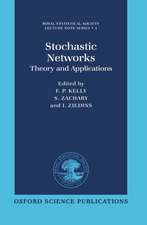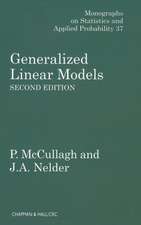The Structural Theory of Probability: New Ideas from Computer Science on the Ancient Problem of Probability Interpretation: Series in Computer Science
Autor Paolo Rocchien Limba Engleză Hardback – 31 ian 2003
Paolo Rocchi, a versatile IBM scientist, outlines a new philosophical and mathematical approach inspired by well-tested software techniques. Through the prism of computer technology he provides an innovative view on the theory of probability. Dr. Rocchi discusses in detail the mathematical tools used to clarify the meaning of probability, integrating with care numerous examples and case studies. The comprehensiveness and originality of its mathematical development make this volume an inspiring read for researchers and students alike.
| Toate formatele și edițiile | Preț | Express |
|---|---|---|
| Paperback (1) | 634.49 lei 6-8 săpt. | |
| Springer Us – noi 2012 | 634.49 lei 6-8 săpt. | |
| Hardback (1) | 637.78 lei 6-8 săpt. | |
| Springer Us – 31 ian 2003 | 637.78 lei 6-8 săpt. |
Din seria Series in Computer Science
- 15%
 Preț: 491.49 lei
Preț: 491.49 lei - 20%
 Preț: 1285.13 lei
Preț: 1285.13 lei - 20%
 Preț: 996.56 lei
Preț: 996.56 lei - 18%
 Preț: 1244.89 lei
Preț: 1244.89 lei - 20%
 Preț: 648.59 lei
Preț: 648.59 lei - 20%
 Preț: 642.19 lei
Preț: 642.19 lei - 20%
 Preț: 986.18 lei
Preț: 986.18 lei - 20%
 Preț: 644.33 lei
Preț: 644.33 lei -
 Preț: 318.07 lei
Preț: 318.07 lei - 20%
 Preț: 332.39 lei
Preț: 332.39 lei - 20%
 Preț: 986.01 lei
Preț: 986.01 lei - 20%
 Preț: 344.42 lei
Preț: 344.42 lei -
 Preț: 266.70 lei
Preț: 266.70 lei - 20%
 Preț: 339.99 lei
Preț: 339.99 lei - 20%
 Preț: 331.74 lei
Preț: 331.74 lei - 15%
 Preț: 513.46 lei
Preț: 513.46 lei - 23%
 Preț: 1043.29 lei
Preț: 1043.29 lei - 20%
 Preț: 260.38 lei
Preț: 260.38 lei - 20%
 Preț: 325.31 lei
Preț: 325.31 lei - 19%
 Preț: 420.42 lei
Preț: 420.42 lei - 20%
 Preț: 695.19 lei
Preț: 695.19 lei - 20%
 Preț: 571.45 lei
Preț: 571.45 lei -
 Preț: 380.78 lei
Preț: 380.78 lei - 23%
 Preț: 580.47 lei
Preț: 580.47 lei - 20%
 Preț: 744.63 lei
Preț: 744.63 lei -
 Preț: 384.51 lei
Preț: 384.51 lei
Preț: 637.78 lei
Preț vechi: 750.33 lei
-15% Nou
Puncte Express: 957
Preț estimativ în valută:
122.06€ • 126.96$ • 100.76£
122.06€ • 126.96$ • 100.76£
Carte tipărită la comandă
Livrare economică 15-29 aprilie
Preluare comenzi: 021 569.72.76
Specificații
ISBN-13: 9780306474286
ISBN-10: 030647428X
Pagini: 162
Ilustrații: IX, 162 p.
Dimensiuni: 155 x 235 x 15 mm
Greutate: 0.35 kg
Ediția:2003
Editura: Springer Us
Colecția Springer
Seria Series in Computer Science
Locul publicării:New York, NY, United States
ISBN-10: 030647428X
Pagini: 162
Ilustrații: IX, 162 p.
Dimensiuni: 155 x 235 x 15 mm
Greutate: 0.35 kg
Ediția:2003
Editura: Springer Us
Colecția Springer
Seria Series in Computer Science
Locul publicării:New York, NY, United States
Public țintă
ResearchCuprins
1 Cultural Roots.- 1.1 Operational analysis.- 1.2 Networks.- 1.3 Innovative improvements.- 2 Critical Remarks.- 2.1 Random events overlooked.- 2.2 Ensemble model.- 2.3 Linguistic model.- 2.4 Which is the probability argument?.- 2.5 A new proposal.- 3 Events and Structures.- 3.1 Connecting is primitive.- 3.2 Entities, relationships and structures.- 3.3 Abstract algebra.- 3.4 Structural model.- 3.5 Structure’s advantages.- 3.6 Successful structures.- 4 Notes on Structural Analysis.- 4.1 Main mechanisms in events.- 4.2 Basic structural forms.- 4.3 Three singular cases.- 4.4 Why they do not have a general application.- 5 Certainty and Uncertainty.- 5.1 Difficulties in investigating the reality.- 5.2 Uncertain details.- 5.3 Structure of levels.- 5.4 What the levels make explicit.- 5.5 Certain and uncertain structures.- 5.6 Uncertainty and randomness.- 5.7 Progressive qualities of knowledge.- 6 Probability.- 6.1 The problem of being.- 6.2 Definition of probability.- 6.3 Advantages from the definition.- 7 Relative Frequency.- 7.1 Rounding.- 7.2 Experimental test.- 7.3 Frequency and probability are identical.- 7.4 Frequency and probability do not coincide.- 7.5 The Law of large numbers.- 7.6 Practical applications of the law.- 8 Objectivism and Subjectivism.- 8.1 The meaning of probability.- 8.2 Theoretical schools.- 8.3 Theory and praxis.- 8.4 Science of indeterminism.- 9 Probability Calculus.- 9.1 The Laplace formula.- 9.2 Function of probability.- 9.3 Theorem of compound probabilities.- 9.4 Theorem of total probabilities.- 9.5 Closing remarks.- 10 Conditional Probability.- 10.1 Effects from causes.- 10.2 Dependence and independence.- 10.3 Probability of the third singular case.- 10.4 The Bayes theorem.- 11 Stochastic Systems.- 11.1 Transition matrix.- 11.2Chapman-Kolmogorov’s theorem.- 11.3 State matrix.- 11.4 Evolution theorem.- 12 Distributions.- 12.1 Distribution functions.- 12.2 Constant distribution.- 12.3 Binomial distribution.- 12.4 Poisson’s distribution.- 12.5 Normal distribution.- 12.6 Compound distributions.- 13 Bivalent and Multivalent Logic.- 13.1 Probability and language.- 13.2 Values of truth and probability.- 13.3 Logic calculus.- 14 Two Applications.- 14.1 Exercise I.- 14.2 Exercise II.- Appendix: History’s Lessons.- 1 Classical culture.- 2 The rule of apodictic reasoning.- 3 Uncertainty appears in jurisprudence.- 4 People begin to calculate chances.- 5 Statistics emerges.- 6 Two veins merge.- 7 Toward a systematic study.- 8 Several fields are invaded.- 9 Multivalent logic.- 10 The fundamentals are still obscure.- Index of Subjects.- Index of Names.
Recenzii
From the reviews:
"The structural theory of probability addresses the interpretation of probability, often debated in the scientific community. … Rocchi’s topical and ever-timely volume proposes a novel, exhaustive solution to this vibrant issue." (Rainer Beedgen, Zentralblatt MATH, Vol. 1069 (20), 2005)
"Probability theory from Pascal to Kolmogorov has focused on the events as sets of outcomes or results, and probablity as a measure attached to these sets. But this ignores the structure of the processes which lead to the outcomes, and the author explores how taking into account the details of the process would lead to a more fundamental understanding of the nature of probability. ... One hopes that in due course the author will develop his theories further and present overwhelmingly persuasive examples of the advantages of his approach." ---MAA reviews
"The structural theory of probability addresses the interpretation of probability, often debated in the scientific community. … Rocchi’s topical and ever-timely volume proposes a novel, exhaustive solution to this vibrant issue." (Rainer Beedgen, Zentralblatt MATH, Vol. 1069 (20), 2005)
"Probability theory from Pascal to Kolmogorov has focused on the events as sets of outcomes or results, and probablity as a measure attached to these sets. But this ignores the structure of the processes which lead to the outcomes, and the author explores how taking into account the details of the process would lead to a more fundamental understanding of the nature of probability. ... One hopes that in due course the author will develop his theories further and present overwhelmingly persuasive examples of the advantages of his approach." ---MAA reviews
Caracteristici
Elaborates on probability theory from the perspective of a software engineer Investigates random events, structures, certainty and uncertainty Defines probability and discusses the relationship between probability and frequency, as well as, objectivism and subjectivism, bivalent and multivalent logic and so on













